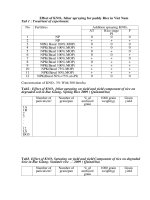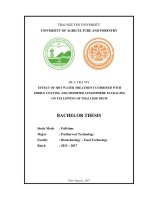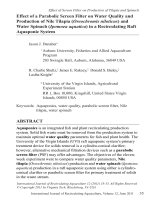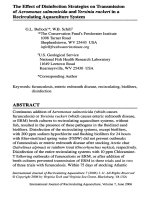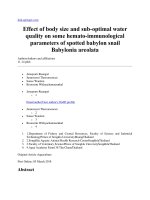Effect of brown seaweed (ascophyllum nodosum)
Bạn đang xem bản rút gọn của tài liệu. Xem và tải ngay bản đầy đủ của tài liệu tại đây (192.26 KB, 9 trang )
39
ผลของการเสริมสาหรายสีน้ําตาล (Ascophyllum nodosum) ในอาหาร
ตอการเจริญเติบโตของหอยหวาน (Babylonia areolata)
Effect of Brown Seaweed (Ascophyllum nodosum) Supplement
in Diet on Growth Performance of Spotted Babylon (Babylonia areolata)
ภุมรินทร เตาวโรดม1 สมเกียรติ ปยะธีรธิติวรกุล2 วีณา เคยพุดซา3 วรินทร ชวศิร4ิ
Bhumrindra Tauvarotama1, Somkiat Piyatiratitivorakul2, Weena Koeypudsa3, Warinthorn Chavasiri4
1
หลักสูตรเทคโนโลยีชีวภาพ คณะวิทยาศาสตร จุฬาลงกรณมหาวิทยาลัย
ภาควิชาวิทยาศาสตรทางทะเล คณะวิทยาศาสตร จุฬาลงกรณมหาวิทยาลัย
3
ภาควิชาอายุรศาสตร คณะสัตวแพทยศาสตร จุฬาลงกรณมหาวิทยาลัย
4
ภาควิชาเคมี คณะวิทยาศาสตร จุฬาลงกรณมหาวิทยาลัย
1
Program in Biotechnology, Faculty of Science, Chulalongkorn University, Thailand
2
Department of Marine Science, Faculty of Science, Chulalongkorn University, Thailand
3
Department of Veterinary Medicine, Faculty of Veterinary Science, Chulalongkorn University, Thailand
4
Department of Chemistry, Faculty of Science, Chulalongkorn University, Thailand
2
บทคัดยอ
มีการศึกษาวิจัยเกี่ยวกับการใชประโยชนจากสาหรายสีน้ําตาล (Ascophyllum nodosum) ในการ
เพาะเลี้ยงสัตว ซึ่งมีผลตอการเจริญเติบโต การเสริมภูมิคุมกัน และการตานโรค ของกุง และปลาหลายชนิด ซึ่ง
ครั้งนี้เปนครั้งแรกในการศึกษาผลของสาหรายตอการเลี้ยงหอย จากการศึกษาพบวาการเสริมสาหราย A.
nodosum ลงในอาหารมีผลดีตอการเจริญเติบโตของหอยหวาน (Babylonia areolata) โดยแบงหอยหวานเปน
สี่กลุม สามซ้ํา เลี้ยงดวยอาหารที่ผสมสาหรายสีน้ําตาล สี่สูตรคือ ผสมสาหรายรอยละ 0 ซึ่งเปนชุดควบคุม รอย
ละ 2.5 รอยละ 5.0 รอยละ 10.0 โดยน้ําหนัก และปลาสด เปนเวลา 30 วัน พบวาการเสริมสาหรายสีน้ําตาล
ใหผลดีกวาชุดควบคุม ทั้งดานความยาวเปลือก และน้ําหนักเปยก อยางมีนัยสําคัญทางสถิติ (P<0.05) แต
ใหผลนอยกวาปลาสด การศึกษาครั้งนี้แสดงใหเห็นถึงศักยภาพของการใชสาหรายเคลปเปนอาหารเสริม และ
ควรมีการศึกษาในดานตาง ๆ อยางตอเนื่อง เพื่อประยุกตใชในการเลี้ยงหอยหวาน
Abstract
Brown seaweed (Ascophyllum nodosum) applications on aquaculture have been studied in
previous researches those presented effects on growth performance, immuno-stimulating and
diseases resistance in many species of shrimp and fish. This research is the pioneer study of
brown seaweed application in mollusk species. Brown seaweed (A. nodosum) meal supplement in
diet presented the good effect on growth performance of spotted babylon (Babylonia areolata). The
young B. areolata were divided into five groups with triplicates. All groups were fed for 30 days with
A. nodosum meal supplement in artificial diet 0% as control diet, 2.5%, 5.0%, 10.0% (w w-1) and fish
meat. The result of A. nodosum supplement showed better effect than control diet both on total shell
length and wet whole body weight with significant difference (P<0.05) but lower than fish meat. This
วารสารวิจัยเทคโนโลยีการประมง ปที่ 3 ฉบับที่ 2 กรกฎาคม – ธันวาคม 2552
40
study presents the potential of A. nodosum as diet supplement and should be continuously studied
for multi-application of B. areolata culture.
1. Introduction
Spotted Babylon (Babylonia areolata) is the new economical marine snail of Thailand and
exportation. At the present, B. areolata quantity is rapidly reducing to the critical level and its size is
smaller than the past while the marketable requirement is rapidly increasing. So, the research of B.
areolata cultural techniques is importance for the production increment and stock enhancement.
Brown seaweed such contains a range of different polysaccharides including alginate,
larminarans and fucoidan those are currently subjects of much research interest to characterize
their structures and understand their biological activities and application potential in many fields.
Particularly interesting is the unique presence of fucoidan, a family of polysaccharides that have
immunological stimulating properties in animals and shows much promise in diseases control and
other feed applications. The inclusion rate of A. nodosum meal in shrimp feed should be around 3.5
to 4%. The average level of fucoidan in A. nodosum is around 5% on dry weight basis (Takahashi
et. al., 1998). This research is the basic knowledge of A. nodosum application on growth
performance in B. areolata.
2. Materials and Methods
2.1 Dietary Preparation
The experimental diets ingredient is shown in Table 1 (modified from Chungthanawong,
2004). The ingredient was mixed by blender and dried at 60°C for 12 h. The three levels of A.
nodosum meal (0%, 2.5%, 5.0% and 10.0%) were added in basal diet. All experimental diets were
stored at 4°C until future use. This dietary formula is primarily done under laboratory conditions. The
composition of experimental diets may not show high efficiency on growth of B. areolata. The
growth performance efficiency comparison between artificial diets and fish was studied. The fresh
fish meat, short body mackerel (Rastrelliger neglectus); as common feed of B. areolata culture was
used in this study.
The proximate analysis of all experimental diets was determined following methods of
Association of Official Analytical Chemists (AOAC, 1996). The stability of all dietary formulas and
วารสารวิจัยเทคโนโลยีการประมง ปที่ 3 ฉบับที่ 2 กรกฎาคม – ธันวาคม 2552
41
fish meat was also tested. The pieces of each diet were soaked in water until those completely
decayed that duration was estimated to the stability period of the diets.
Table 1 Ingredient of artificial diets for the experiment
Ingredients
R. neglectus
Fish Meal
Soybean Meal
Wheat Flour
Shrimp Head Meal
Wheat Gluten
Fish Oil
Vitamin Mixture
Mineral Mixture
A. nodosum Meal
Basal Diet
40
5
25
5
16
5
2
2
0
% (w w-1)
Formula 1
Formula 2
40
40
5
5
22.5
20
5
5
16
16
5
5
2
2
2
2
2.5
5
Formula 3
40
5
15
5
16
5
2
2
10
Fish Meat
100%
-
2.2 Experimental B. areolata
The juvenile B. areolata was obtained from The Research and Technology Transfer Unit of
the Spotted Babylon (Babylonis areolata) Station, Aquatic Resources Research Institute,
Chulalongkorn University, Pechaburi Province. The average range of the total shell length and wet
body weight of B. areolata is between 0.8 to 1.3 cm and 1.10 to 1.20 g, respectively. The B.
areolata was fed with R. neglectus, acclimatized to ambient laboratory culture condition. B. areolata
was fed once daily and uneaten food was removed after the feeding. When the experiment was
started, the healthy B. areolata were selected from the acclimatized stock and transferred to the
experimental tanks. The initial average of total shell length and wet body weight were recorded.
2.3 Experimental Cultural Unit and Facilities
The high concentrate sea water of the salt farm was used as rearing water in this
experimental cultural unit. The salt water was diluted to 30‰ and stocked for three days before use.
The rearing water qualities were monitored along this experimental period and removed about 60%
daily. Clearly circular plastic tanks (20 cm Ø × 30 cm H) were used as rearing tanks. Sandy
material was not filled into the tank. The air supply was set and opened in every cultural tank.
วารสารวิจัยเทคโนโลยีการประมง ปที่ 3 ฉบับที่ 2 กรกฎาคม – ธันวาคม 2552
42
2.4 Growth Performance Experiment of B. areolata
150 healthy B. areolata were divided into five groups with triplicates at 10 B. areolata per
tank. Each group was fed on 30 days with A. nodosum meal supplement in diet 0%, 2.5%, 5.0%
and 10.0% (w w-1) and R. neglectus. They were fed once daily, uneaten food and fecal matter were
removed by siphon after feeding and the rearing water was removed about 60% daily. The growth
parameters were calculated as follows (Zhou et al., 2007, Brett, 1979 and Sang-ngam, 1998):
Specific growth rate, SGR
=
(ln final size - ln initial size) × 100 …………………………………(1)
number of feeding day
…………………………....………..(2)
Feed conversion ratio, FCR =
weight of feed
(final weght - initial weght)
Percent Weight gain, WG =
final weight × 100 ……………………….………………………….(3)
initial weight
Percent Shell length increase, SLI =
(final shell length - initial shell lelngth) × 100 …………(4)
initial shell elngth
2.5 Water Qualities Determination
The major qualities of the rearing water were measured every day along the experimental
period. Salinity was measured by Hand-Held Refractometer (Atago®), temperature was measured
by handle thermometer, pH was measured by indicator paper, dissolve oxygen (DO), total ammonia
and total alkalinity were measured by test kits (AQUA–VBC®).
2.6 Statistical Analyses
All of the experiments in this study were set on completely randomized design (CRD). All
parameters were statistical evaluated using analysis of variance at level of significance 0.05,
homogeneity of variance and multiple comparisons by Duncan’s New Multiple Range Tests at
confidence interval 95% (Sang-ngam, 1998 and Sokal and Rohlf, 1981).
3. Results
3.1 Experimental Diets
The result of proximate analysis of experimental diets is shown in Table 2. In four artificial
diets, the basal diet is the highest average of protein percentage and significant difference
(P>0.05). The average of lipid percentage is no significant difference (P>0.05). The A. nodosum
วารสารวิจัยเทคโนโลยีการประมง ปที่ 3 ฉบับที่ 2 กรกฎาคม – ธันวาคม 2552
43
10% formula is the highest average ash, moisture and fiber percentage. The stability of all
experimental diets is approximately 2.0 h. The fish meat showed different results.
Table 2 Dietary proximate analysis of the experiment
Diet Formulas
Protein (%)
Basal Diet
44.30 ± 0.03a
A. nodosum 2.5% 43.92 ± 0.07ab
A. nodosum 5.0% 43.78 ± 0.01ab
A. nodosum 10.0% 43.56 ± 0.03b
Fish Meat
19.07 ± 0.53c
Lipid (%)
10.48 ± 0.17b
10.48 ± 0.09b
10.34 ± 0.11b
10.31 ± 0.04b
12.63 ± 0.57a
Contents
Ash (%)
12.84 ± 0.14d
13.60 ± 0.17c
15.37 ± 0.05b
16.21 ± 0.13a
1.39 ± 0.13e
Moisture (%)
7.52 ± 0.01a
7.28 ± 0.06a
7.23 ± 0.05a
7.18 ± 0.02a
67.04 ±1.64b
Fiber (%)
2.62 ± 0.02c
2.73 ± 0.13bc
2.84 ± 0.06b
3.11 ± 0.12a
>0.01 ± 0.00d
Stability
(h)
2
2
2
2
>2
Note: Mean ± SD (n=3) and the same superscript indicates non significant difference (P>0.05)
3.2 Efficiency of A. nodosum Meal Supplement in Diet on the Growth of B. areolata
The results of A. nodosum meal supplement in diet on the growth of B. areolata are shown
in Tables 3 and 4. The means of total shell length and wet body weight of B. areolata are significant
difference (P<0.05). Fish meat showed the highest average of total length, wet body weight, FCR,
SLI, SGR and WG. A. nodosum meal supplement 2.5% in diet exhibited high of all parameters than
other formulas. Survival rate of B. areolata was 100% in all dietary treatments which not showed
significant effect on survival rate.
3.3 Water Qualities
The major qualities of the rearing water were determined everyday. The range of
temperature was 27 to 28°C, salinity was 27 to 30‰, pH was 8.0 to 8.5, dissolved oxygen (DO) is 6
to 8 mg L-1, total ammonia was 0.00 to 0.2 and alkalinity was 150 to157 mg L-1
Table 3 Growth on total shell length and wet body weight of B. areolata with different diets
Diet Formulas
A. nodosum 0%
A. nodosum 2.5%
A. nodosum 5.0%
A. nodosum 10.0%
Fish Meat
Total Length (mm)
Initial
Final
18.10 ± 0.24 21.11 ± 0.34c
18.10 ± 0.24 21.23 ± 0.20b
18.10 ± 0.24 21.17 ± 0.20bc
18.10 ± 0.24 21.11 ± 0.16c
18.10 ± 0.24 22.61 ± 0.14a
Wet Weight (g)
Initial
Final
1.18 ± 0.13
2.17 ± 0.03b
1.18 ± 0.13
2.17 ± 0.02b
1.18 ± 0.13
2.14 ± 0.02c
1.18 ± 0.13
2.10 ± 0.06d
1.18 ± 0.13
2.98 ± 0.12a
Survival
Rate (%)
100
100
100
100
100
วารสารวิจัยเทคโนโลยีการประมง ปที่ 3 ฉบับที่ 2 กรกฎาคม – ธันวาคม 2552
44
Table 4 Growth indexes of B. areolata with different diets
SGR (%/day)
Total Length Wet Weight
A. nodosum 0%
0.51 ± 0.05bc 2.03 ± 0.05b
A. nodosum 2.5% 0.53 ± 0.03b 2.03 ± 0.03b
A. nodosum 5.0% 0.52 ± 0.03bc 1.99± 0.03c
A. nodosum 10.0% 0.51 ± 0.02c 1.92 ± 0.02d
Fish Meat
0.74 ± 0.02a 3.10 ± 0.01a
Formulas
FCR
SLI (%)
2.03 ± 0.06e 16.63 ± 1.89c
2.06 ± 0.04d 17.31 ± 1.01bc
2.09 ± 0.04c 16.96 ± 1.01c
2.18 ± 0.03b 16.59 ± 0.89c
3.86 ± 0.03a 24.90 ± 0.77a
WG (%)
184.02 ± 2.71b
183.67 ± 1.59b
181.50 ± 1.45c
178.14 ± 1.16d
252.91 ± 1.04a
Note: Mean ± SD (n=30, triplicate) and the same superscript indicates non significant difference (P>0.05). Initial weight was
about 1.18 ± 0.13 g and initial shell length was 18.10 ± 0.24 cm. SGR: specific growth rate, FCR: feed conversion ratio, SLI:
shell length increase, WG: weight gain
4. Discussion
4.1 Experimental Artificial Diets
The proximate analysis of all experimental artificial dietary formulas showed high level of
protein content. The high protein formula showed good effect on survival and growth of healthy B.
areolata than low protein formula (Sang-ngam, 1997). The high A. nodosum level formula showed
high ash and fiber content that may be affected on A. nodosum content (Chungthanawong, 2004).
The stability of the experimental diets for 2 h is long enough for babylon feeding.
4.2 Efficiency of A. nodosum Meal Supplement in Diet on the Growth of B. areolata
The effect of seaweed on growth performance has been studied in pig (Turner et al., 2002),
calve (Evans et al., 2002), fish (Valente et al., 2006 and Davies et al., 1997) and shrimp
(Chungthanawong, 2004), but no on mollusk species. In this study, A. nodosum supplement
showed the effect on growth of B. areolata. In terms of total shell length, the B. areolata fed with A.
nodosum 2.5% and 5.0% dietary formulas were significantly longer than those from control and
10.0% formulas. In terms of wet weight, B. areolata which were fed with A. nodosum 0% and 2.5%
dietary formulas were significantly heavier than those from 5.0% and 10.0% formulas. However, A.
nodosum meal supplement 0% and 2.5% were no significant difference on total shell length and wet
body weight. In particular, there was no importance for A. nodosum meal supplement in diet
because A. nodosum exhibited unclear effect on growth performance of B. areolata.
These results showed that the growth gain of juvenile B. areolata increased with high
protein of artificial diets. These results are similar to those in other mollusk species (Uki et al., 1986,
Mai et al., 1995). On the basis of this study, 45% protein in artificial diet may be recommended for
วารสารวิจัยเทคโนโลยีการประมง ปที่ 3 ฉบับที่ 2 กรกฎาคม – ธันวาคม 2552
45
growth of B. areolata. The optimal protein level for abalone was between 20% and 35% (Uki and
Watanabe 1992). These differences might be that B. areolata was a carnivorous or scavenger
mollusk whereas abalone was omnivorous or herbivorous.
The B. areolata fed with fish meat showed the highest growth than other formulas since fish
meat was an appropriately feed. The artificial diet is important for intensive aquaculture in long term
due to the production of fish being not stable on market supply and can be designed to many
requirements. Thus the research on artificial diet of B. areolata should be continuously developed.
4.3 Water Qualities
All water parameters along the experimental period were rather stable because the water
was exchanged 60% daily after feeding. The qualities of water were in the standard range for
aquaculture and the culture density was suitable for the growth of juvenile B. areolata (Liu and Xiao,
1998 and Chaitanawisuti and Kritsanapuntu 2002).
5. Conclusion and Recommendation
The B. areolata feeding high level of A. nodosum supplement in artificial diet exhibited bad
significant effect on growth of B. areolata than those feed low level or none of A. nodosum
supplement. A. nodosum may not be an effective diet material on growth performance but may be
an effective in other properties of B. areolata. This research is the pioneer study on the potential
utilization of A. nodosum application in B. areolata culture. The related fields of this study should be
continued studying such as chemistry, biochemistry and bioactivity of A. nodosum.
6. Acknowledgements
This research was supported by The Thailand Research Fund – Master Research Grants
(MAG Window II) Co-funding and The 90th Anniversary of Chulalongkorn University Fund
(Ratchadaphiseksomphot Endowment Fund).
7. Refferences
Association of Official Analytical Chemists (AOAC). 1996. Official Methods of Analysis of Official
Analytical Chemists International, 16th ed. Association of Official Analytical Chemists,
Arlington,VA.
Brett, J.R. 1979. Environmental Factors and Growth. In Hoar, W.S.; Randall, D.J. and Brett, J.R.
(eds.). Fish Physiology. Vol. 8: 599-667. New York: Academic Press.
วารสารวิจัยเทคโนโลยีการประมง ปที่ 3 ฉบับที่ 2 กรกฎาคม – ธันวาคม 2552
46
Chaitanawisuti, N. and Kritsanapuntu, S. 2002. Handbook of Spotted Babylon Culture: Principle
and Practice. 1st ed. The 8th Book of Researches Publicize Project. Bangkok: Chulalongkorn
University Press. 114 p. (in Thai)
Chungthanawong, S. 2004. Effect of Kelp Supplement in Diet on Resistance to Disease in Black
Tiger Shrimp Penaeus monodon. Master’s Thesis Thesis. Department of Marine Science,
Faculty of Science, Chulalongkorn University, Thailand. 83 p.
Davies, S.J.; Brown, M.T. and Camilleri, M. 1997. Preliminary Assessment of the Seaweed Porphyra
purpurea in Artificial Diets for Thick-lipped Grey Mullet (Chelon labrosus). Aquaculture 152:
249–258.
Evans, R.R.; Best, T.F.; Ivy, R.L. and Allen, V.G. 2002. Seaweed (Ascophyllum nodosum)
Supplementation for Backgrounding Weanling or Purchased Calves. Annual Report of the
North Mississippi Research & Extension Center, Miss. Agric. & For. Expt. Sta. Info. Bull:
196-197.
Liu, D.J. and Xiao, S.Q. 1998. Preliminary Study on Ecology of Babylonia formosae. J. Fish. Sci.
China 5, 93–96 (In Chinese with English abstract).
Mai, K.; Mercer, J.P. and Donlon, J. 1995. Comparative Studies on the Nutrition of Two Species of
Abalone Haliotis tuberculate L. and Haliotis discus hannai Ino. III. Optimum dietary protein
for growth. Aquaculture 134, 165–180.
Sang-ngam, K. 1998. Effect of Protein and Lipid in Semi-Artificial Diets on Growth of Spotted
Babylon, Babylonia areolata. Senior Project. Department of Marine Science, Faculty of
Science, Chulalongkorn University, Thailand. (in Thai)
Sokal, R.R. and Rohlf, F.J. 1981. Biometry. 2nd ed. New York: W.H. Freeman and Company. 895 p.
Takahashi, Y.; Uahara, K.; Watanabe, R.; Okumura, T,; Yamashita, T.; Omura, H.; Yomo, T.;
Kawano, T.; Kanemithu, A.; Narasaka, H.; Suzuki, N. and Itami, T. 1998. Efficacy of Oral
Administration Shrimp in Japan. In: Flegel, T.W. (ed.), Advances in Shrimp Biotechnology.
National Center for Genetic Engineering and Biotechnology,Bangkok, pp. 171– 173.
Turner, J.L.; Dritz, S.S., Higgins, J.J. and Minton, J.E. 2002. Effects of Ascophyllum nodosum
Extract on Growth Performance and Immune Function of Young Pigs Challenged with
Salmonella typhimurium. J. Anim. Sci. 80: 1947-1953
Uki, N.; Kemuyama, A. and Watanabe, T. 1986. Optimum Protein Level in Diets for Abalone. Bull.
Jpn. Soc. Sci. Fish. 52, 1005 - 1012 (In Japanese with English abstract).
วารสารวิจัยเทคโนโลยีการประมง ปที่ 3 ฉบับที่ 2 กรกฎาคม – ธันวาคม 2552
47
Uki, N. and Watanabe, T. 1992. Review of Nutritional Requirements of Abalone (Haliotis spp.) and
Development of more Efficient Artificial Diets. In: Shepherd, S.A., Tegner, M.J., Guzman Del
Proo, S.A. (eds.), Abalone of the world: Fisheries Biology and Culture. Proceeding of the 1st
International Symposium on Abalone. Fishing News Books, Oxford, pp. 504–517.
Valente, L.M.P.; Gouveia, A.; Rema, P.; Matos, J.; Gomes, E.F. and Pinto, I.S. 2006. Evaluation of
Three Seaweeds Gracilaria bursa-pastoris, Ulva rigida and Gracilaria cornea as Dietary
Ingredients in European Sea Bass (Dicentrarchus labrax) juveniles. Aquaculture 252: 85-91
Zhou, J.B.; Zhou, Q.C.; Chi, S.Y.; Yang, Q.H. and Liu, C.W. 2007. Optimal Dietary Protein
Requirement for Juvenile Iory Shell, Babylonia areolate. Aquaculture 270: 186 - 192
วารสารวิจัยเทคโนโลยีการประมง ปที่ 3 ฉบับที่ 2 กรกฎาคม – ธันวาคม 2552

